
Amantadine
- Molecular Formula C10H17N
- Average mass 151.249 Da
Synthesis, p. 457, 1976

AMANTADINE HYDROCHLORIDE
- Molecular FormulaC10H18ClN
- Average mass187.710 Da
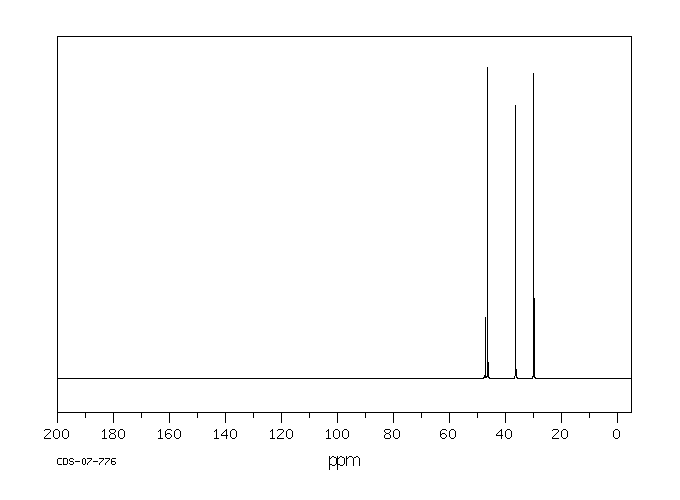
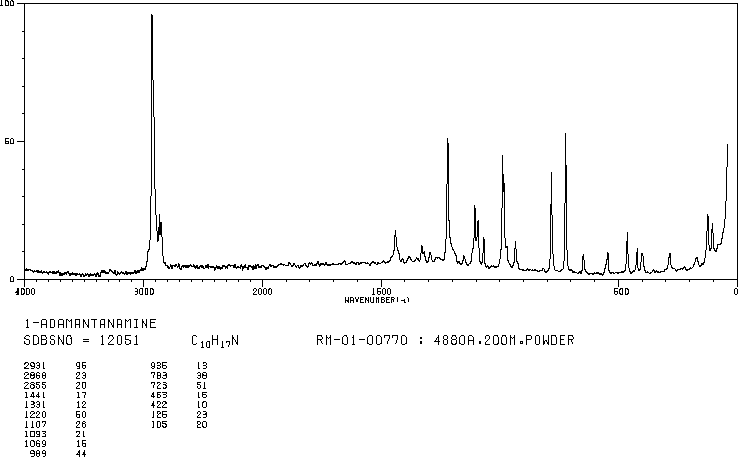

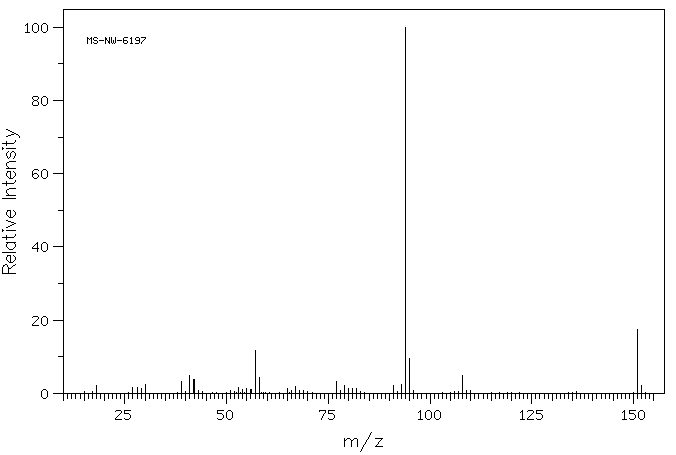
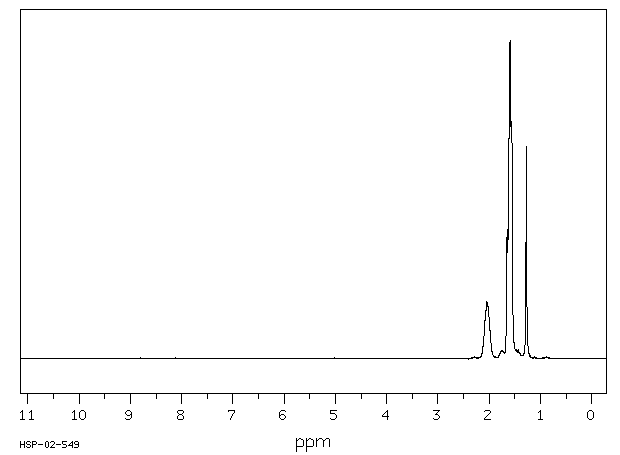
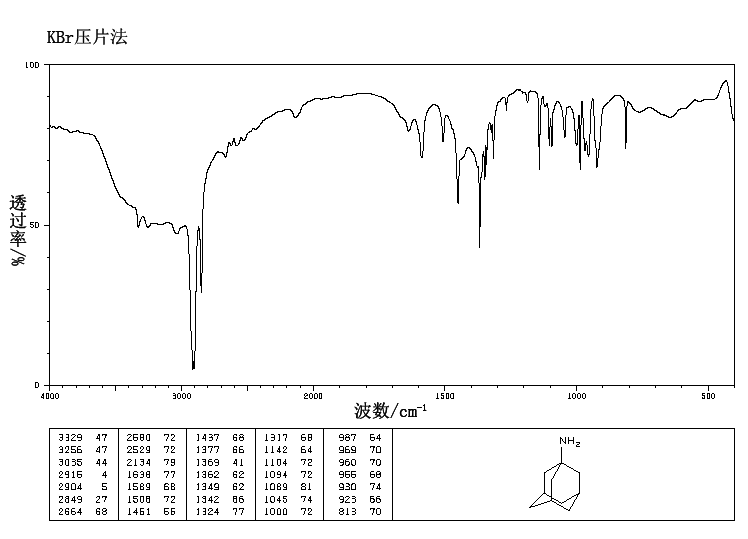
Amantadine (trade name Symmetrel, by Endo Pharmaceuticals) is a drug that has U.S. Food and Drug Administration approval for use both as an antiviral and an antiparkinsonian drug. It is the organic compound 1-adamantylamine or 1-aminoadamantane, meaning it consists of an adamantane backbone that has an amino group substituted at one of the four methyne positions. Rimantadineis a closely related derivative of adamantane with similar biological properties.
Apart from medical uses, this compound is useful as a building block in organic synthesis, allowing the insertion of an adamantyl group.
According to the U.S. Centers for Disease Control and Prevention (CDC) 100% of seasonal H3N2 and 2009 pandemic flu samples tested showed resistance to adamantanes, and amantadine is no longer recommended for treatment of influenza in the United States. Additionally, its effectiveness as an antiparkinsonian drug is undetermined, with a 2003 Cochrane Review concluding that there was insufficient evidence in support of or against its efficacy and safety.[2]
Medical uses
Parkinson’s disease
Amantadine is used to treat Parkinsons disease, as well as parkinsonism syndromes.[3] A 2003 Cochrane review concluded evidence was inadequate to support the use of amantadine for Parkinson’s disease.[2]
An extended release formulation is used to treat dyskinesia, a side effect of levodopa which is taken by people who have Parkinsons.[4]
Influenza
Amantadine is no longer recommended for treatment of influenza A infection. For the 2008/2009 flu season, the CDC found that 100% of seasonal H3N2 and 2009 pandemic flu samples tested have shown resistance to adamantanes.[5] The CDC issued an alert to doctors to prescribe the neuraminidase inhibitors oseltamivir and zanamivir instead of amantadine and rimantadine for treatment of flu.[6][7] A 2014 Cochrane review did not find benefit for the prevention or treatment of influenza A.[8]
Fatigue in multiple sclerosis
Amantadine also seems to have moderate effects on multiple sclerosis (MS) related fatigue.[9]
Adverse effects
Amantadine has been associated with several central nervous system (CNS) side effects, likely due to amantadine’s dopaminergic and adrenergic activity, and to a lesser extent, its activity as an anticholinergic. CNS side effects include nervousness, anxiety, agitation, insomnia, difficulty in concentrating, and exacerbations of pre-existing seizure disorders and psychiatric symptoms in patients with schizophrenia or Parkinson’s disease. The usefulness of amantadine as an anti-parkinsonian drug is somewhat limited by the need to screen patients for a history of seizures and psychiatric symptoms.
Rare cases of severe skin rashes, such as Stevens-Johnson syndrome,[10] and of suicidal ideation have also been reported in patients treated with amantadine.[11][12]
Livedo reticularis is a possible side effect of amantadine use for Parkinson’s disease.[13]
Influenza
The mechanisms for amantadine’s antiviral and antiparkinsonian effects are unrelated. The mechanism of amantadine’s antiviral activity involves interference with the viral protein, M2, a proton channel.[14][15] After entry of the virus into cells via endocytosis, it is localized in acidic vacuoles; the M2 channel functions in transporting protons with the gradient from the vacuolar space into the interior of the virion. Acidification of the interior results in disassociation of ribonucleoproteins, and the initiation of viral replication. Amantadine and rimantadine function in a mechanistically identical fashion in entering the barrel of the tetrameric M2 channel, and blocking pore function (i.e., proton translocation). Resistance to the drug class is a consequence of mutations to the pore-lining residues of the channel, leading to the inability of the sterically bulky adamantane ring that both amantadine and rimantadine share, in entering in their usual way, into the channel.[citation needed]
Influenza B strains possess a structurally distinct M2 channels with channel-facing side chains that fully obstruct the channel vis-a-vis binding of adamantine-class channel inhibitors, while still allowing proton flow and channel function to occur; this constriction in the channels is responsible for the ineffectiveness of this drug and rimantadine towards all circulating Influenza B strains.
Parkinson’s disease
Amantadine is a weak antagonist of the NMDA-type glutamate receptor, increases dopamine release, and blocks dopamine reuptake.[16] Amantadine probably does not inhibit MAO enzyme.[17] Moreover, the mechanism of its antiparkinsonian effect is poorly understood.[citation needed] The drug has many effects in the brain, including release of dopamine and norepinephrine from nerve endings. It appears to be a weak NMDA receptor antagonist[18][19] as well as an anticholinergic, specifically a nicotinic alpha-7 antagonist like the similar pharmaceutical memantine.
In 2004, it was discovered that amantadine and memantine bind to and act as agonists of the σ1 receptor (Ki = 7.44 µM and 2.60 µM, respectively), and that activation of the σ1receptor is involved in the dopaminergic effects of amantadine at therapeutically relevant concentrations.[20] These findings may also extend to the other adamantanes such as adapromine, rimantadine, and bromantane, and could explain the psychostimulant-like effects of this family of compounds.[20]
History
Amantadine was approved by the U.S. Food and Drug Administration in October 1966 as a prophylactic agent against Asian influenza, and eventually received approval for the treatment of influenzavirus A[21][22][23][24] in adults. In 1969, the drug was also discovered by accident upon trying to help reduce symptoms of Parkinson’s disease, drug-induced extrapyramidal syndromes, and akathisia.
In 2017, the U.S. Food and Drug Administration approved the use of amantadine in an extended release formulation developed by Adamas Pharma for the treatment of dyskinesia, an adverse effect of levodopa, that people with Parkinson’s experience.[25]
Veterinary misuse
In 2005, Chinese poultry farmers were reported to have used amantadine to protect birds against avian influenza.[26] In Western countries and according to international livestock regulations, amantadine is approved only for use in humans. Chickens in China have received an estimated 2.6 billion doses of amantadine.[26] Avian flu (H5N1) strains in China and southeast Asia are now resistant to amantadine, although strains circulating elsewhere still seem to be sensitive. If amantadine-resistant strains of the virus spread, the drugs of choice in an avian flu outbreak will probably be restricted to the scarcer and costlier oseltamivir and zanamivir, which work by a different mechanism and are less likely to trigger resistance.
On September 23, 2015, the US Food and Drug Administration announced the recall of Dingo Chip Twists “Chicken in the Middle” dog treats because the product has the potential to be contaminated with amantadine.[27]


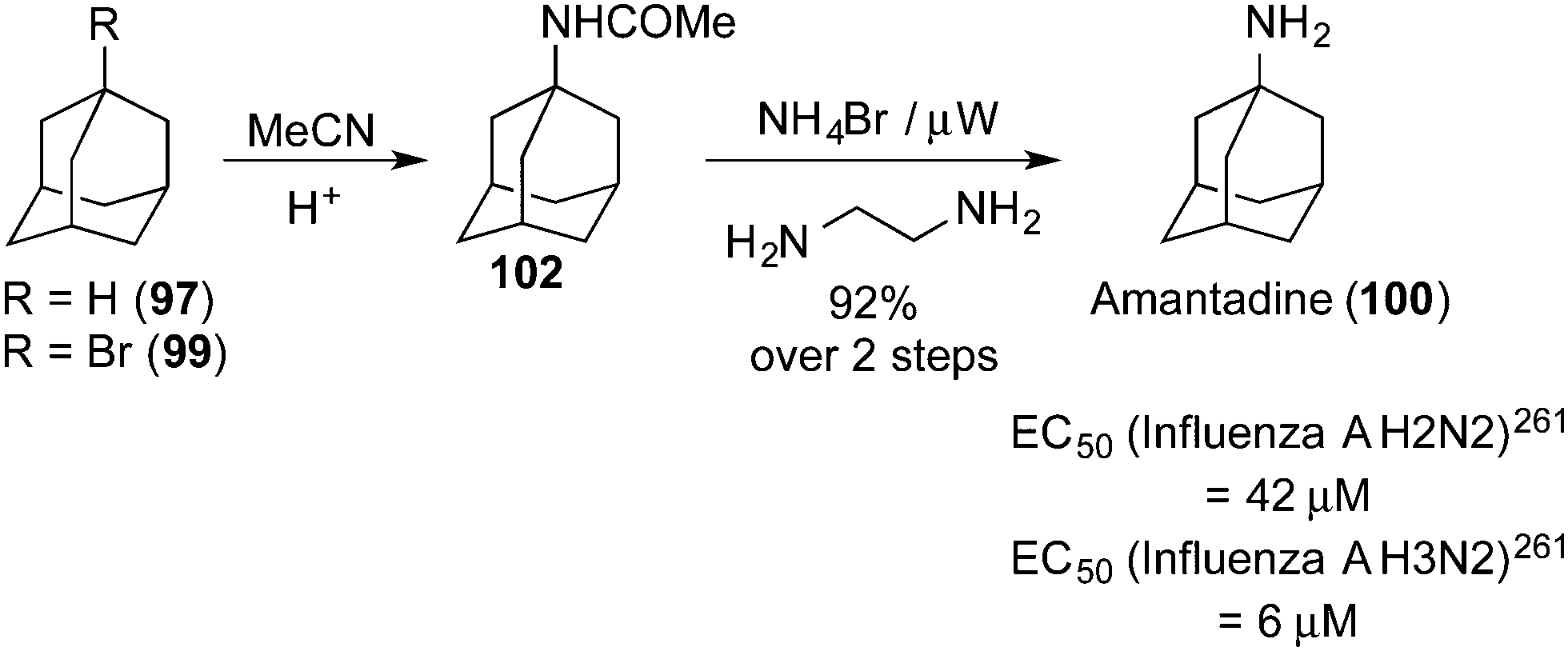

PAPER
An Improved Synthesis of Amantadine Hydrochloride
http://pubs.acs.org/doi/10.1021/acs.oprd.7b00242
Amantadine hydrochloride 1 is an antiviral drug used in the prevention and treatment of influenza A infections. It has also been used for alleviating early symptoms of Parkinson’s disease. Several methods for the preparation of 1 have been reported. These procedures started with adamantane 2 using as many as four reaction steps to produce amantadine hydrochloride with overall yields ranging from 45% to 58%. In this article, we describe a two-step procedure for the synthesis of 1from 2 via N-(1-adamantyl)acetamide 4 with an improved overall yield of 67%. The procedure was also optimized to reduce the use of toxic solvents and reagents, rendering it more environment-friendly. The procedure can be considered as suitable for large-scale production of amantadine hydrochloride. The structure of amantadine hydrochloride was confirmed by 1H NMR, 13C NMR, IR, and MS.
Amantadine Hydrochloride (1)




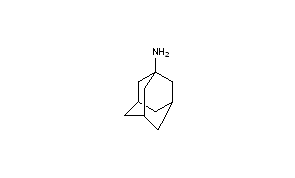 Title: Amantadine
CAS Registry Number: 768-94-5
CAS Name: Tricyclo[3.3.1.13,7]decan-1-amine
Additional Names: 1-adamantanamine; 1-aminoadamantane; 1-aminodiamantane (obsolete); 1-aminotricyclo[3.3.1.13,7]decane
Molecular Formula: C10H17N
Molecular Weight: 151.25
Percent Composition: C 79.41%, H 11.33%, N 9.26%
Literature References: NMDA-receptor antagonist; also active vs influenza A virus. Prepn: H. Stetter et al., Ber. 93, 226 (1960); W. Haaf, ibid. 97, 3234 (1964); P. Kovacic, P. D. Roskos, Tetrahedron Lett. 1968, 5833. Antiviral activity: W. L. Davies et al.,Science 144, 862 (1964). GC determn in biological samples and pharmacodynamics: W. E. Bleidner et al., J. Pharmacol. Exp. Ther. 150, 484 (1965). Pharmacology and toxicology: V. G. Vernier et al., Toxicol. Appl. Pharmacol. 15, 642 (1969). Comprehensive description: J. Kirschbaum, Anal. Profiles Drug Subs. 12, 1-36 (1983). Review of use vs influenza A: R. L. Tominack, F. G. Hayden, Infect. Dis. Clin. North Am. 1, 459-478 (1987); of pharmacokinetics: F. Y. Aoki, D. S. Sitar, Clin. Pharmacokinet. 14, 35-51 (1988). Review of NMDA receptor binding and neuroprotective properties: J. Kornhuber et al., J. Neural Transm. 43, Suppl., 91-104 (1994). Series of articles on clinical experience in Parkinson’s disease: ibid. 46, Suppl., 399-421 (1995).
Properties: Crystals by sublimation, mp 160-190° (closed tube) (Stetter). Also reported as mp 180-192° (Haaf). pKa: 10.1. Sparingly sol in water.
Melting point: mp 160-190° (closed tube) (Stetter); mp 180-192° (Haaf)
pKa: pKa: 10.1
Derivative Type: HydrochlorideCAS Registry Number: 665-66-7
Manufacturers’ Codes: EXP-105-1; NSC-83653
Trademarks: Adekin (Desitin); Lysovir (Alliance); Mantadan (Boehringer, Ing.); Mantadine (Endo); Mantadix (BMS); Symmetrel (Endo); Virofral (Novo)
Molecular Formula: C10H17N.HCl
Molecular Weight: 187.71
Percent Composition: C 63.99%, H 9.67%, N 7.46%, Cl 18.89%
Properties: Crystals from abs ethanol + anhydr ether, mp >360° (dec). Freely sol in water (at least 1:20); sol in alcohol, chloroform. Practically insol in ether. LD50 orally in mice, rats: 700, 1275 mg/kg (Vernier).
Melting point: mp >360° (dec)
Toxicity data: LD50 orally in mice, rats: 700, 1275 mg/kg (Vernier)
Derivative Type: Sulfate
CAS Registry Number: 31377-23-8
Trademarks: PK-Merz (Merz)
Molecular Formula: C10H17N.½H2SO4
Molecular Weight: 200.29
Percent Composition: C 59.97%, H 9.06%, N 6.99%, S 8.00%, O 15.98%
Therap-Cat: Antiviral; antiparkinsonian.
Keywords: Antidyskinetic; Antiparkinsonian; Antiviral.
|
 |
|
 |
|
| Clinical data | |
|---|---|
| Trade names | Symmetrel |
| Synonyms | 1-Adamantylamine |
| AHFS/Drugs.com | Monograph |
| MedlinePlus | a682064 |
| Pregnancy category |
|
| Routes of administration |
Oral |
| ATC code | |
| Legal status | |
| Legal status | |
| Pharmacokinetic data | |
| Bioavailability | 86–90%[1] |
| Protein binding | 67%[1] |
| Metabolism | Minimal (mostly to acetyl metabolites)[1] |
| Biological half-life | 10–31 hours[1] |
| Excretion | Urine[1] |
| Identifiers | |
| CAS Number | |
| PubChem CID | |
| IUPHAR/BPS | |
| DrugBank | |
| ChemSpider | |
| UNII | |
| KEGG | |
| ChEBI | |
| ChEMBL | |
| ECHA InfoCard | 100.011.092 |
| Chemical and physical data | |
| Formula | C10H17N |
| Molar mass | 151.249 g/mol |
| 3D model (JSmol) | |
References
- ^ Jump up to:a b c d e “SYMMETREL® (amantadine hydrochloride)” (PDF). TGA eBusiness Services. NOVARTIS Pharmaceuticals Australia Pty Limited. 29 June 2011. Retrieved 24 February2014.
- ^ Jump up to:a b Crosby, Niall J; Deane, Katherine; Clarke, Carl E (2003). Clarke, Carl E, ed. “Amantadine in Parkinson’s disease”. Cochrane Database of Systematic Reviews. doi:10.1002/14651858.CD003468.
- Jump up^ “Amantadine – FDA prescribing information,”. Drugs.com. Retrieved 2017-08-28.
- Jump up^ “Amantadine extended release capsules” (PDF). FDA. August 2017. For label updates, see FDA index page for NDA 208944
- Jump up^ CDC weekly influenza report – week 35, cdc.gov
- Jump up^ “CDC Recommends against the Use of Amantadine and Rimantadine for the Treatment or Prophylaxis of Influenza in the United States during the 2005–06 Influenza Season”. CDC Health Alert. Centers for Disease Control and Prevention. 2006-01-14. Archived from the original on 3 May 2008. Retrieved 2008-05-20.
- Jump up^ Deyde, Varough M.; Xu, Xiyan; Bright, Rick A.; Shaw, Michael; Smith, Catherine B.; Zhang, Ye; Shu, Yuelong; Gubareva, Larisa V.; Cox, Nancy J.; Klimov, Alexander I. (2007). “Surveillance of Resistance to Adamantanes among Influenza A(H3N2) and A(H1N1) Viruses Isolated Worldwide”. Journal of Infectious Diseases. 196 (2): 249–257. PMID 17570112. doi:10.1086/518936.
- Jump up^ Alves Galvão, MG; Rocha Crispino Santos, MA; Alves da Cunha, AJ (21 November 2014). “Amantadine and rimantadine for influenza A in children and the elderly.”. The Cochrane database of systematic reviews. 11: CD002745. PMID 25415374. doi:10.1002/14651858.CD002745.pub4.
- Jump up^ Braley, TJ; Chervin, RD (Aug 2010). “Fatigue in multiple sclerosis: mechanisms, evaluation, and treatment.”. Sleep. 33 (8): 1061–7. PMC 2910465
 . PMID 20815187.
. PMID 20815187. - Jump up^ Singhal, KC; Rahman, SZ (2002). “Stevens Johnson Syndrome Induced by Amantadine”. Rational Drug Bulletin. 12 (1): 6.
- Jump up^ “Symmetrel (Amantadine) Prescribing Information” (PDF). Endo Pharmaceuticals. May 2003. Retrieved 2007-08-02.
- Jump up^ Cook, PE; Dermer, SW; McGurk, T (1986). “Fatal overdose with amantadine”. Canadian Journal of Psychiatry. 31 (8): 757–8. PMID 3791133.
- Jump up^ Vollum, DI; Parkes, JD; Doyle, D (June 1971). “Livedo reticularis during amantadine treatment”. Br Med J. 2 (5762): 627–8. PMC 1796527
 . PMID 5580722. doi:10.1136/bmj.2.5762.627.
. PMID 5580722. doi:10.1136/bmj.2.5762.627. - Jump up^ Wang C, Takeuchi K, Pinto LH, Lamb RA (1993). “Ion channel activity of influenza A virus M2 protein: characterization of the amantadine block”. Journal of Virology. 67 (9): 5585–94. PMC 237962
 . PMID 7688826.
. PMID 7688826. - Jump up^ Jing X, Ma C, Ohigashi Y, et al. (2008). “Functional studies indicate amantadine binds to the pore of the influenza A virus M2 proton-selective ion channel”. Proc. Natl. Acad. Sci. U.S.A. 105 (31): 10967–72. PMC 2492755
 . PMID 18669647. doi:10.1073/pnas.0804958105.
. PMID 18669647. doi:10.1073/pnas.0804958105. - Jump up^ Jasek, W, ed. (2007). Austria-Codex (in German) (62nd ed.). Vienna: Österreichischer Apothekerverlag. p. 3962. ISBN 978-3-85200-181-4.
- Jump up^ Strömberg, U.; Svensson, T. H. (November 1971). “Further Studies on the Mode of Action of Amantadine”. wiley.com. Acta Pharmacologica et Toxicologica, Nordic Pharmacological Society. 30 (3–4): 161–171. doi:10.1111/j.1600-0773.1971.tb00646.x.
- Jump up^ Kornhuber, J; Bormann, J; Hübers, M; Rusche, K; Riederer, P (1991). “Effects of the 1-amino-adamantanes at the MK-801-binding site of the NMDA-receptor-gated ion channel: a human postmortem brain study”. Eur. J. Pharmacol. Mol. Pharmacol. Sect. 206: 297–300. doi:10.1016/0922-4106(91)90113-v.
- Jump up^ Blanpied, TA; Clarke, RJ; Johnson, JW (2005). “Amantadine inhibits NMDA receptors by accelerating channel closure during channel block”. Journal of Neuroscience. 25 (13): 3312–22. PMID 15800186. doi:10.1523/JNEUROSCI.4262-04.2005.
- ^ Jump up to:a b Peeters, Magali; Romieu, Pascal; Maurice, Tangui; Su, Tsung-Ping; Maloteaux, Jean-Marie; Hermans, Emmanuel (2004). “Involvement of the sigma1 receptor in the modulation of dopaminergic transmission by amantadine”. European Journal of Neuroscience. 19 (8): 2212–2220. ISSN 0953-816X. PMID 15090047. doi:10.1111/j.0953-816X.2004.03297.x.
- Jump up^ Hounshell, David A.; Kenly Smith, John (1988). Science and Corporate Strategy: Du Pont R&D, 1902–1980. Cambridge University Press. p. 469.
- Jump up^ “Sales of flu drug by du Pont unit a ‘disappointment'”. The New York Times. Wilmington, Delaware. October 5, 1982. Retrieved May 19, 2008.
- Jump up^ Maugh, T. (1979). “Panel urges wide use of antiviral drug”. Science. 206 (4422): 1058–60. PMID 386515. doi:10.1126/science.386515.
- Jump up^ Maugh, T. H. (1976). “Amantadine: an Alternative for Prevention of Influenza”. Science. 192 (4235): 130–1. PMID 17792438. doi:10.1126/science.192.4235.130.
- Jump up^ Bastings, Eric. “NDA 208944 Approval Letter” (PDF).
- ^ Jump up to:a b Sipress, Alan (2005-06-18). “Bird Flu Drug Rendered Useless”. Washington Post. pp. A01. Retrieved 2007-08-02.
- Jump up^ “Enforcement Report – Week of September 23, 2015”. FDA.gov. US Food and Drug Administration, US Department of Health & Human Services.
/////////////
















